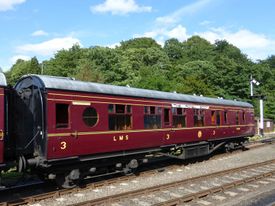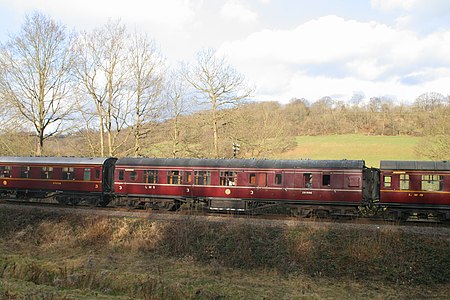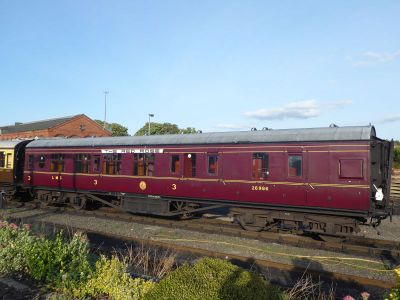LMS 26986 Brake Third Corridor
| LMS 26986 Brake Third Corridor | |
|---|---|
 LMS 26986 Brake Third Corridor | |
| Built By | BR Wolverton |
| Status | In service |
| Number | 26986 |
| Other numbers | M26986M |
| History | |
| Built | 1951 |
| Designed By | Stanier / Ivatt |
| Diagram | 2161 |
| Lot | 1506 |
| Type | CH, BTK |
| Length | 57ft |
| Weight | 30T |
| Seats | 24 third |
| 1971 | Arrived on SVR |
| 1975 | Attended Rail 150 at Shildon |
The LMS had begun to build the first batches of all-steel, welded construction coaches by 1938, although the Second World War and post-war rationing of steel interrupted this programme. Sir William Stanier was succeeded as CME of the LMS by C E Fairburn in 1944 and H G Ivatt in 1945. Although neither produced any new carriage designs, they did implement some of Stanier's style changes. Among those was the port-hole stock, echoing that used by the 1938 streamliners. Construction of this 57ft stock continued for several years under BR, although unlike the all-steel Corridor Composite version, the BTK still made use of timber framing with steel top, bottom and corner members. It provided seating for 24 passengers in six compartments and included one toilet.
Contents
Service
26986 was built in 1951 by BR at Wolverton as lot number 1506 to diagram number 2161.[1] The livery when new in service was BR Crimson and Cream. It continued use in BR's London Midland region as number M26986M until being withdrawn in November 1969,[2] by which time it had been repainted in BR's blue and grey livery.[3]
Preservation
26986 was privately purchased by a member of the L.M.S. & B.R. Coach Fund, together with spares from another vehicle in worse condition. It was collected from Worcester on 20 September 1971 and delivered to Bewdley by the diesel hauled train bringing LMR 600 Gordon and three Ex-Longmoor Saloons from the Longmoor Military Railway via Didcot.
Restoration, which included repainting in LMS 1946 Crimson Lake livery, was carried out at Bewdley and was completed in early 1973.[4] On 11 August 1973 26986 visited the Derby Litchurch Lane Carriage Works Open Day in the company of LMS 8233, LMS 12992 Corridor Third and LMS Stove R 32919, the journey being made in steam.[5]
Two years later 26986 was one of the three SVR carriages which attended the Rail 150 celebrations at Shildon in 1975, travelling there on 11 August behind 8233 and 43106. It is the only one of the three carriages still based at the SVR.[6][note 1]
26986 was withdrawn from service in Autumn 1982 after being vandalised by an air rifle. During preparation for the repairs several rotten 3x3 timbers were found. The Coach Fund therefore decided that 26986 should take the place of LMS Brake Third Corridor 26880 at their stores vehicle at Bridgnorth, allowing the latter to be rebuilt as it was thought to be in better condition despite having spent a number of years stored at Eardington.[7] By winter 1987-88 the LMS set was without a brake, so 26986 became the 'big winter job'.[8] The renovation eventually took around a year, during which time the defective corner posts and centre rails were replaced, while the vestibule floor was also removed and replaced by a galvanized steel floor covered with tongue-and-groove boards. The external panels were all scrapped and new panels cut out and welded together to form a continuous skin. The seats were removed and sent away for reupholstering and the interior woodwork was stripped and re-varnished. 26986 was finally repainted and lined out in LMS 1947 style, returning to service in late 1988.[9]
In early 1997 the decision was taken to smarten up the LMS Set. 26986 had not been repainted for ten years, resulting in an 8 week visit to the paint shop. During that time several volunteers also undertook the complete reconditioning of the Guard's area. The coach was outshopped just before the Santa services but did not return to traffic until the following January as the sets had already been formed.[10] In comparison, 26986 received a 5-yearly touch-up and re-varnish in September 2001 which took just 4 days work in total.[11]
The coach underwent another overhaul between March and June 2009,[12] while the seats were reupholstered in 2013.[13]
n 2016 its future as part of the SVR's LMS carriage fleet was assured through its purchase by the SVR Charitable Trust.[14] 26986 forms part of the LMS Maroon set (Set L), notwithstanding that it was not built until after nationalisation.
Gallery
See also
Notes
- ↑ On-loan "Clapham Buffet" GWR 9631 later returned to the NRM, while LNER pigeon van 4236 was subsequently swapped for LNER 24105.
References
Links
| ||||||||||||||||||||||||||||||

